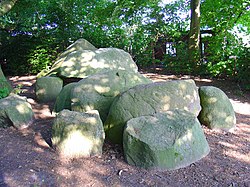Passage graves of Midlaren
| Passage graves of Midlaren Hunenborg, Großsteingrab Midlaren-West, Großsteingrab Midlaren-Oost Hunebed D3, Hunebed D4 |
||
|---|---|---|
|
The large stone grave D3 in Midlaren |
||
|
|
||
| Coordinates | Midlaren D3 , Midlaren D4 | |
| place | Tynaarlo , OT Midlaren , Drenthe , The Netherlands | |
| Emergence | 3470 to 2760 BC Chr. | |
| van Giffen no. | D3, D4 | |
The passage graves of Midlaren (also called Hunenborg ) are two megalithic tombs of the Neolithic western group of the Funnel Beaker Culture (TBK) near Midlaren , a district of Tynaarlo in the Dutch province of Drenthe . The graves bear the Van Giffen numbers D3 and D4.
location
The two graves are only about 5.0 m away from each other in an east-west direction between the old farmhouses ( keuterijtjes ) on Schusweg no. 40 and 42. 1.2 km to the north-west is the Noordlaren large stone grave (G1).
Research history
The graves were first mentioned in 1711 by Ludolf Smids , who mistakenly believed them to be a contiguous complex. Several drawings of the graves were made in the 18th and early 19th centuries: in 1754 by Cornelis Pronk , in 1768/69 by Petrus Camper and in 1812 by Antoine Ignace Melling . In 1870 the mound fillings of the graves were removed. In 1918 Albert Egges van Giffen documented the facilities for his atlas of the Dutch megalithic graves. A systematic archaeological excavation or a major restoration has not yet taken place. In 1965 only a minor repair was carried out on grave D4. The facilities have been national monuments ( Rijksmonumenten ) since 1973 .
description
Grave D3
The complex is an approximately east-west oriented passage grave . A stone enclosure could not be found. The burial chamber has a length of 10.7 m and a width of 4.4 m. It has six pairs of wall stones on the long sides, one end stone each on the narrow sides and six cap stones. The access to the chamber is in the middle of the southern long side. In front of this is a corridor made of two wall stones.
Grave D4
The complex is also an east-west oriented passage grave. A stone enclosure could not be found. The burial chamber has a length of 14.8 m and a width of 3.9 m. It originally had seven pairs of wall stones on the long sides, one end stone each on the narrow sides and seven cap stones. Except for one wall stone on the northern long side, all stones have been preserved. The capstones are all inside the chamber. The access to the chamber is located between the third and fourth wall stones on the southern long side, seen from the west. In front of this is a corridor made of two wall stones. Of the original gang stones, only the eastern one may have survived. The western one seems to be a stone that van Giffen found relocated to the south-west corner of the chamber when he was photographed in 1918. Van Giffen interpreted it as a blown off fragment of the westernmost capstone.
Finds
The finds that were made during the removal of the mound found their way into the Drents Museum in Assen , the Rijksmuseum van Oudheden in Leiden and partly also in the British Museum in London .
According to Willem Pleyte , a piece of tuff was found in one of the graves in the 19th century . According to Jan Albert Bakker , it could be an import piece from the Eifel .
In 2003, during the restoration of the Schutsweg 40 farmhouse, a pit was discovered that was filled with material removed from one of the grave chambers. This evacuation had probably taken place during the use of the graves by the members of the funnel cup culture. The pit contained numerous shards of ceramic vessels, including a terrine .
See also
literature
- Jan Albert Bakker : The TRB West Group. Studies in the Chronology and Geography of the Makers of Hunebeds and Tiefstich Pottery. Universiteit van Amsterdam, Amsterdam 1979, ISBN 978-90-70319-05-2 .
- Jan Albert Bakker: The Dutch Hunebedden. Megalithic Tombs of the Funnel Beaker Culture. International Monographs in Prehistory, Ann Arbor 1992, ISBN 1-87962-102-9 .
- Jan Albert Bakker: Megalithic Research in the Netherlands, 1547-1911. From 'Giant's Beds' and 'Pillars of Hercules' to accurate investigations. Sidestone Press, Leiden 2010, ISBN 9789088900341 , p. 205 ( online version ).
- Evert van Ginkel , Sake Jager, Wijnand van der Sanden: Hunebedden. Monuments van een steentijdcultuur. Uniepers, Abcoude 1999, ISBN 978-9068252026 , p. 166.
- Albert Egges van Giffen : De Hunebedden in Nederland , 3 volumes. Oosthoek, Utrecht 1925.
- G. de Leeuw: Onze hunebedden. Gids before Drentse hunebedden en de Trechterbekerkultuur . Flint 'Nhoes, Borger 1984.
- Wijnand van der Sanden , Hans Dekker: Gids voor de hunebedden in Drenthe en Groningen . WBooks, Zwolle 2012, ISBN 978-9040007040 .
- Jürgen E. Walkowitz: The megalithic syndrome. European cult sites of the Stone Age (= contributions to the prehistory and early history of Central Europe. Vol. 36). Beier & Beran, Langenweißbach 2003, ISBN 3-930036-70-3 .
Web links
- The Megalithic Portal: D3 Midlaren , D4 Midlaren
- hunebedden.nl: Hunebedden D3 en D4 te Midlaren
- hunebeddeninfo.nl: D3 en D4 / Midlaren
- JohnKuipers.ca: D3 Midlaren , D4 Midlaren
- cruptorix.nl: D3: Hunenborg , D4: Hunenborg
Individual evidence
- ^ Anna L. Brindley : The typochronology of TRB West Group pottery. In: Palaeohistoria. Volume 28, 1986, pp. 93-132 ( online ). Annual figures corrected according to Moritz Mennenga : Between Elbe and Ems. The settlements of the funnel beaker culture in northwest Germany (= early monumentality and social differentiation. Volume 13). Habelt, Bonn 2017, ISBN 978-3-7749-4118-2 , p. 93 ( online ).
- ^ Rijksdienst voor het Cultureel Erfgoed: 45452 te Midlaren


